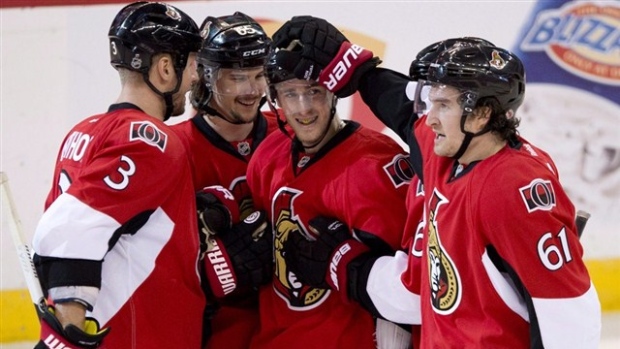Sep 30, 2014
Yost: The challenge of replacing Jason Spezza
The general consensus for this season is that the Ottawa Senators will struggle to beat last year's 88-point total, primarily due to the fact that replacement options for Jason Spezza seem limited. And as TSN Analytics Writer Travis Yost explains, that will leave a big challenge for centres Kyle Turris and Mika Zibanejad.

Just over a week until the start of the season, it's almost impossible to get a feel for how the Ottawa Senators will look. This is probably tied into the fact that their expected results and actual results have been all over the place over the last three years - the first two with Ottawa handily beating low expectations and the Senators woefully underperforming lofty 'dark horse' talk last season.
The general consensus for this season is that the team will struggle to beat last year's 88-point total, primarily due to the fact that replacement options for Jason Spezza seem limited. Two of the three pieces in the trade that moved Spezza to Dallas will not play in the NHL this season, while the third - Alex Chiasson - is penciled in as a second/third-line winger. The franchise knows the difficulty of replacing such a prominent scorer, but believes they'll be a better team down the road after the three-for-one swap.
Though the team was guarded in talking about Spezza's departure, I found it interesting how the team was using him last season. Despite being the face of the franchise and the highest-paid player on the team, head coach Paul MacLean deployed Spezza as the team's second-line centre. And he did this frequently.
The emergence of Kyle Turris as a bona fide top-six pivot certainly helped things along, but it was fascinating to see the paradigm quietly shift during last season. Take, for example, a comparison of Turris and Spezza's teammates last year. Intuitively, first-line centres should enjoy more talented teammates - the trio earning decisive ice-time and, by virtue of deployment, facing tougher waves of competition.
That said, I've compiled quality of teammate numbers (based on ice time) for each centre and graphed it (first graph) using a 10-game rolling average. The higher the number, the better the teammate (Turris in blue, Spezza in red).

If you watched a lot of Ottawa last season, the fact that Turris' saw a better assortment of teammates than Spezza shouldn't be surprising. Turris played 75 per cent of his minutes with Clarke MacArthur, 66 per cent of his minutes with Bobby Ryan, and about 50 per cent of his minutes with Erik Karlsson. On the other hand, the only other regular forward Jason Spezza played with was the older Milan Michalek - Spezza played about 69 per cent of his minutes with the aging winger.
As for the brief inversion of the teammate quality in the above graph, it can be explained in two words: Ales Hemsky. Ottawa acquired Hemsky at the deadline and put him on Spezza's wing, and the two made beautiful magic in their brief time together. That brief stretch aside, it was clear Spezza was getting second-rate forwards, at least relative to the younger Turris.
We know how Paul MacLean assembled the lineup. But, how did other teams react to Paul MacLean's lineup assembly? Let's focus on the quality of competition each center faced on the left graph, again in rolling 10-game averages.

The second graph (Turris in blue, Spezza in red) is best captured in one statement. Teams viewed the MacArthur-Turris-Ryan line as Ottawa's biggest threat. Spezza's line generally saw weaker competition than Turris' line and it would seem rather clear that part of it was due to the fact that Turris was surrounded by better wingers. Spezza, less so. This also makes sense if you consider that, after the Senators acquired Ales Hemsky, Spezza's line started to see a comparable or tougher wave of relative competition.
Ultimately, replacing Spezza's production - his 2.22 points/60 was good for 25th in the league last year, a very respectable number - will prove difficult in the short-term for MacLean. But I think part of solving this issue is properly isolating the question.
Ottawa's going to need massive efforts from centres Mika Zibanejad, David Legwand, and Zack Smith this year as they attempt to mitigate the loss of Spezza and his 18-plus minutes from their lineup. The trickle-down effect is real and seeing if those who are replacing Spezza's minutes - especially the young Zibanejad - will be game to handle an increased workload is going to be one of the coaching staff's biggest challenges. There's also the massive absence on the power play, where Spezza's magical playmaking ability and corresponding ice-time will be sorely missed.
One question that doesn't need to be answered, though, is how to replace the loss of a first-line centre. Ottawa subtly answered that question one season ago.

